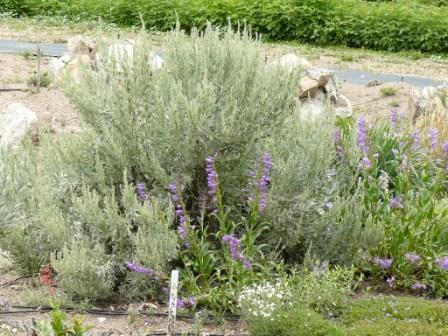Artemisia tridenta vaseyana in the Landscape

Laura Smith, Westscape Nursery, Bozeman, Montana. Photo credit: Diane Jones, Draggin
Scientfic Name: Artemisia tridentata vaseyanaCommon Name: Mountain Big Sagebrush
Description: Mountain Big Sagebrush is an evergreen shrub 2-5' tall dependent on location and elevation. Commonly found in mountain landscapes at edges of forest and moist to dry meadow and slope settings.
Native Habitat: Mountain Big Sagebrush grows in dry to moist, well drained meadows and slopes at higher elevations. This shrub tolerates a wide range of soil types and moisture regimes. It is often associated with forbs and low growing grasses.
Cultural Requirement
Soil: Range from coarse to fine textures and pH ranges neutral to slightly alkaline. Does not tolerate clay soils. Avoid saline soils.
Moisture Tolerance: Range from annual precipitation of 11"-45".
Sun/Shade/Preference: Requires full sun and has very low shade tolerance. Requires full sun for seed establishment.
Transplanting: Is relatively easy during the late spring and summer from containerized material and bare root (spring only). Avoid winter and late fall transplanting.
Propagation: Easiest by seed.
Maintenance (pruning, fertilization, deadheading, division, irrigation, etc): Tolerates moderate to low fertilization but does not tolerate salt.
Insect, disease, or other problems: Can be susceptible to many foliar and root pathogens such as Powdery Mildew and Fusarium Root Rot. Check for aphids in early spring.
Landscape Value
Use in the Landscape: Commonly used to naturalize meadows and forest edges in reconstructed landscapes at higher elevations. Grows faster and has a softer look than Artemisia tridentata wyomingensis (Wyoming Big Sage).
Foliage: Blue to slightly Blue/green.
Flower: Inconspicuous flowers.
Timing: Apr May June July Aug Sept Oct
Form: Erect Shrub
Ultimate Size: 2-5' depending on conditions.
Rate of Growth: Medium to slow dependent on moisture and temperature.
Suggested Plant Partners: Use is commonly as a specimen shrub in combination with low growing bunch grasses and perennials.
Availability: Good in native and specialty nurseries.
References:
Munshower, F.F. 1995. Forbs, shrubs, and trees for revegetation of disturbed lands in the northern Great Plains and adjacent areas. Montana State University, Reclamation Research Unit Publ. No. 9505
Rose, R, C.E.C. Chachulski, and D.L. Haase. 1998. Propagation of Pacific Northwest native plants. Oregon State University Press. ISBN 0-87071-428-7
USDA Plant Database

